

Learning How to Learn: Powerful mental tools to help you master tough subjects - University of California, San Diego. Visual Strategies. Key words: different formats, space, graphs, charts, diagrams, maps and plans Description: This preference uses symbolism and different formats, fonts and colors to emphasise important points.

It does not include video and pictures that show real images and it is not Visual merely because it is shown on a screen. If you have a strong Visual preference for learning you should use some or all of the following: To take in the information: lecturers who use gestures and picturesque languagepictures, videos, posters, slidesflowchartsunderlining, different colours, highlighterstextbooks with diagrams and picturesgraphssymbols @ and white space SWOT – Study without tears To make a learnable package: Convert your “notes” into a learnable package by reducing them (3:1) Use all of the techniques aboveReconstruct the images in different ways… try different spatial arrangements.Redraw your pages from memoryReplace words with symbols or initialsLook at your pages.
Mod 2: ESL Learner > Learning Styles. Athletic Training Education Program. Overview of Learning Styles Many people recognize that each person prefers different learning styles and techniques.

Learning styles group common ways that people learn. Everyone has a mix of learning styles. Some people may find that they have a dominant style of learning, with far less use of the other styles. Others may find that they use different styles in different circumstances. Google Image Result for. Educational Leadership:Teaching for Multiple Intelligences:Integrating Learning Styles and Multiple Intelligences. September 1997 | Volume 55 | Number 1 Teaching for Multiple Intelligences Pages 22-27 In the 20th century, two great theories have been put forward in an attempt to interpret human differences and to design educational models around these differences.
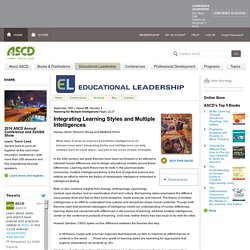
Learning-style theory has its roots in the psychoanalytic community; multiple intelligences theory is the fruit of cognitive science and reflects an effort to rethink the theory of measurable intelligence embodied in intelligence testing. Both, in fact, combine insights from biology, anthropology, psychology, medical case studies, and an examination of art and culture. But learning styles emphasize the different ways people think and feel as they solve problems, create products, and interact.
The theory of multiple intelligences is an effort to understand how cultures and disciplines shape human potential. Howard Gardner (1993) spells out the difference between the theories this way: How People Learn. This teaching guide highlights the pedagogical theory presented in the book: How People Learn: Brain, Mind, Experience and School John D.
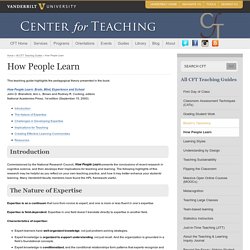
Bransford, Ann L. Brown and Rodney R. Cocking, editors National Academies Press; 1st edition (September 15, 2000) Introduction Commissioned by the National Research Council, How People Learn presents the conclusions of recent research in cognitive science, and then develops their implications for teaching and learning. The Nature of Expertise Expertise is on a continuum that runs from novice to expert, and one is more or less fluent in one’s expertise. Expertise is field-dependent. Characteristics of expertise: Active learning pedagogies - the University of Queensland, Australia. ‘The evidence suggests that PBL is an instructional approach that offers the potential to help students develop flexible understanding and lifelong learning skills.’
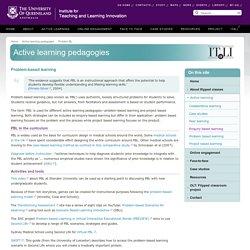
(Hmelo-Silver, 2004) Problem-based learning (also known as 'PBL') uses authentic, loosely structured problems for students to solve. Students receive guidance, but not answers, from facilitators and assessment is based on student performance. Active learning pedagogies - the University of Queensland, Australia. Project-based learning ... gives students the opportunity to gain a deep understanding of concepts and potentially allows them to solve the society’s problems.
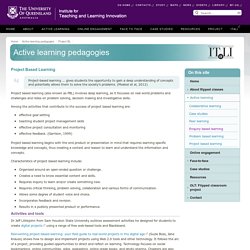
(Moalosi et al, 2012) Project based learning (also known as PBL) involves deep learning, as it focusses on real world problems and challenges and relies on problem solving, decision making and investigative skills. Among the activities that contribute to the success of project based learning are: effective goal setting teaching student project management skills effective project consultation and monitoring effective feedback. The social/situational orientation to learning. The social/situational orientation to learning.

It is not so much that learners acquire structures or models to understand the world, but they participate in frameworks that that have structure. Learning involves participation in a community of practice. Social learning theory ‘posits that people learn from observing other people. By definition, such observations take place in a social setting’ (Merriam and Caffarella 1991: 134). Within psychology, initially it was behaviourists who looked to how people learned through observation.
Learning would be exceedingly laborious, not to mention hazardous, if people ha d to rely solely on the effects of their own actions to inform them what to do. Attending to a behaviour; remembering it as a possible model or paradigm; and playing out how it may work for them in different situations (rehearsal) are key aspects of observational learning. Symbols retained from a modelling experience act as a template with which one’s actions are compared.
Learning theory: models, product and process. Photo by Antenna on Unsplash.
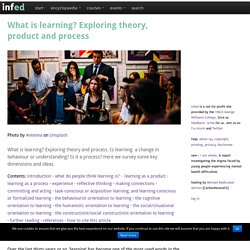
Learning Theories, Learning Models, Learning Theory Summaries - in Plain English! How-people-learn.pdf.